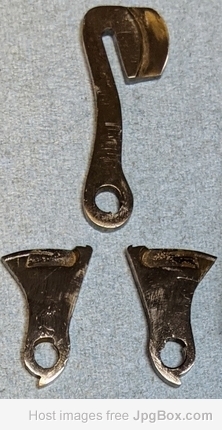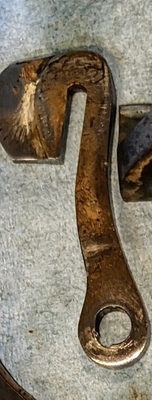To help with this conversation I will post photos from each of the hammer pins.
Original pin
Left end

Right end

(note, the visible mark was enhanced by me with a file and is much more pronounced than what was an original scribe mark or scratch)
Gun Parts Co pin #1 (short at only +1.215 in length)


GPC pin #2


These pin ends do not look anything like the rather pronounced, almost screw slot style, pin head as shown in Dewey's video. It would be instructive if Dewey would reverse the pin in the Lefever used in the video and then record a video showing that the hammers will or will not cock with this reversal.
When I first disassembled this Lefever I took photos of the parts. I reviewed these photos and I found a couple of the pin end of the hook. Note this keyway is far from the rectangular shape of the pin key. More like the hammer keyway in my view.


As my last point, reading both books by Elliot and studying the patent drawings I find no information to suggest directionality for the pin. Studying my frame I cannot identify any type of taper or offset that would require or permit a unidirectional pin insertion.
From everything I have now read, Lefever was about efficiency in design. I find it odd that he would design a system that required each pin to be filed to fit and inserted only in a specific direction. How would a production shop manage this with thousands of frames, varying sizes, and thousands of pins. And what about providing replacement pins? Clearly these pins broke and where replaced as suggested by my pin.
I have no idea as to why my G did not cock with the new pin. The new pin was made to an exact duplicate in all dimensions to the original. All I can offer is that perhaps in my cleaning up of the cocking hook I removed a burr that was just enough to ensure adequate rotation of the hammer pin. I cocked the gun when I acquired it, but not again before disassembly. Also I first started a conversation on this forum by asking how to remove the barrels on a Lefever. I received a number of suggestions. I am now convinced that this difficulty in doing so was and is caused by excessive vertical movement in the cocking hook indicative of wear in the hook keyway.